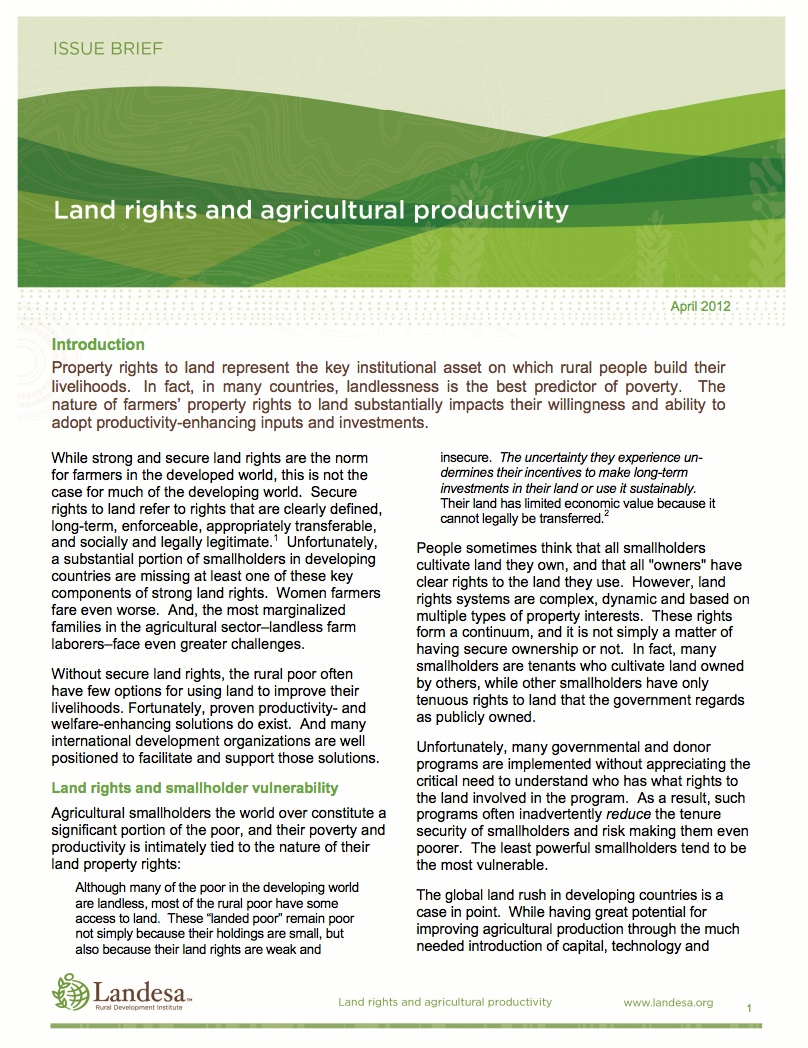Details
Location
Contributions
Displaying 701 - 710 of 2403Women’s empowerment and nutrition: An evidence review
This paper starts by reflecting on the concept and measurement of women’s empowerment and then reviews some of the structural interventions that aim to influence underlying gender norms in society and eradicate gender discrimination. It then proceeds to review the evidence of the impact of three types of interventions—cash transfer programs, agricultural interventions, and microfinance programs—on women’s empowerment, nutrition, or both.
Women’s Rights and the Right to Food
In the present report, submitted to the Human Rights Council in accordance with Council resolution 13/4, the Special Rapporteur on the right to food discusses the threats to women's right to food, identifying the areas that demand the most urgent attention. The report examines successively the obstacles women face in access to employment, social protection and the productive resources needed for food production, food processing and value chain development.
The Effects of Intrahousehold Property Ownership on Expenditure Patterns in Ghana
Increasingly, economists are examining how the dynamics within households affect the outcomes of household decisions. This paper uses data from the 1991/92 and the 1998/99 Ghana Living Standards Surveys to examine how the share of assets owned by women in Ghanaian households affects household expenditure patterns. In this analysis, assets include business assets, savings, and farmland. The results indicate that women’s share of assets do have an impact on household budget shares for a number of expenditure categories in each time period.
Journal of African Economies
The Journal of African Economies is a vehicle to carry rigorous economic analysis, focused entirely on Africa, for Africans and anyone interested in the continent - be they consultants, policymakers, academics, traders, financiers, development agents or aid workers.
PubMed Central
PubMed Central® (PMC) is a free full-text archive of biomedical and life sciences journal literature at the U.S. National Institutes of Health's National Library of Medicine (NIH/NLM).
Do discriminatory social institutions matter for food security?
In view of the 2012 United Nations Commission on the Status of Women’s thematic focus on rural women’s empowerment, the gender team at the Development Centre has launched an issues paper, “Do discriminatory social institutions matter for food security?”.
Land Tenure, Property Rights, and Gender
While many people in the developing world lack secure property rights and access to adequate resources, women have less access to land than men do in all regions and in many countries (Food and Agriculture Organization of the United Nations [FAO], 2011b). Women across the developing world are consistently less likely to own land, have fewer rights to land, and the land they do own or have access to is of lower quality in comparison to men
(FAO, 2011b).
The State of Food and Agriculture: Climate Change, Agriculture and Food Security
The Paris Agreement, adopted in December 2015, represents a new beginning in the global effort to stabilize the climate before it is too late. It recognizes the importance of food security in the international response to climate change, as reflected by many countries focusing prominently on the agriculture sector in their planned contributions to adaptation and mitigation. To help put those plans into action, this report identifies strategies, financing opportunities, and data and information needs.
Household Welfare Effects of Low-cost land certification in Ethiopia
Several studies have shown that the land registration and certification reform in Ethiopia has been implemented at an impressive speed, at a low-cost, and with significant impacts on investment, land productivity, and land rental market activity. This study provides new evidence on land productivity changes for rented land and on the welfare effects of the reform. The study draws on a unique household panel, covering the period up to eight years after the implementation of the reform.
Land Rights and Agricultural Productivity
Property rights to land represent the key institutional asset on which rural people build their livelihoods. In fact, in many countries, landlessness is the best predictor of poverty. The nature of farmers’ property rights to land substantially impacts their willingness and ability to adopt productivity-enhancing inputs and investments.











